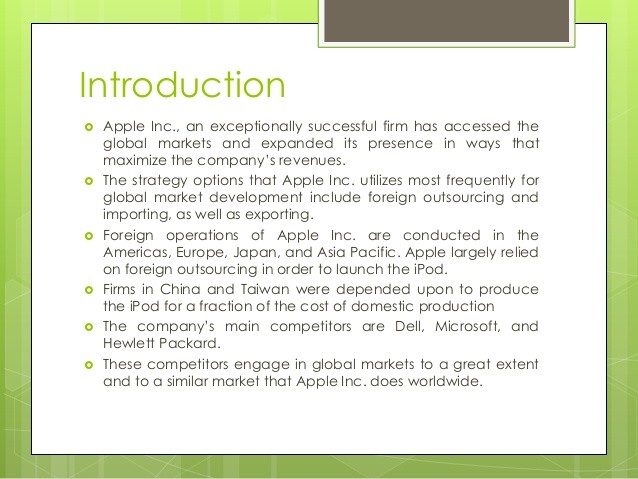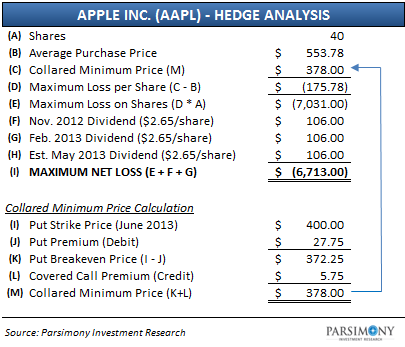How a Protective Collar Works (AAPL)
Post on: 12 Апрель, 2015 No Comment

A protective collar consists of a put option purchased to hedge the downside risk on a stock, plus a call option written on the stock to finance the put purchase. Another way to think of a protective collar is as a combination of a covered call plus long put position.
The put and call are typically out-of-the-money (OTM) options, but have the same expiration and ideally are for the same number of contracts (equivalent to the number of shares held). The combination of the long put and short call forms a collar for the underlying stock that is defined by the strike prices of the put and call options. The protective aspect of this strategy arises from the fact that the put position provides downside protection for the stock until the put expires.
Since the basic objective of the collar is to hedge downside risk, it stands to reason that the strike price of the call written should be higher than the strike put of the put purchased. Thus if a stock is trading at $50, a call on it may be written with a strike price of say $52.50, with a put purchased with a strike price of $47.50. The $52.50 call strike price provides a cap for the stock’s gains, since it can be called away when it trades above the strike price. Likewise, the $44.50 put strike price provides a floor f or the stock, as it provides downside protection below this level.
A protective collar is usually implemented when the investor requires downside protection for the short- to medium-term, but at a lower cost. Since buying protective puts can be an expensive proposition, writing OTM calls can defray the cost of the puts quite substantially. In fact, it is possible to construct protective collars for most stocks that are either costless – these are also called zero-cost collars – or actually generate a net credit for the investor.
The main drawback of this strategy is that the investor is giving away upside in the stock in exchange for obtaining downside protection. The protective collar works like a charm if the stock declines, but not so well if the stock surges ahead and is called away, as any additional gain above the call strike price will be lost.
Thus, in the earlier example where a covered call is written at $52.50 on a stock that is trading at $50, if the stock subsequently rises to $55, the investor who has written the call would have to surrender the stock at $52.50, forgoing an additional $2.50 in profit. If the stock advances to $65 before the call expires, the call writer would forgo an additional $12.50 (i.e. $65 minus $52.50) in profit, and so on.
Protective collars therefore are particularly useful when the broad markets or specific stocks are showing signs of retreating after a sizeable advance. They should be used with caution in a strong bull market, as the odds of stocks being called away (and thus capping the upside of a specific stock or portfolio) may be quite high.
Let’s understand how a protective collar can be constructed for Apple, Inc. (AAPL ) which closed at $109.25 on January 12, 2015. Assume you hold 100 shares of Apple that you purchased at $70, and with the stock up 56% from your purchase price, you would like to implement a collar to protect your gains.
You start by writing a covered call on your Apple position. The March 2015 $115 calls are trading at $3.65 / $3.75, so you write one contract (that has 100 AAPL shares as the underlying asset) to generate premium income of $365 (less commissions). You concurrently also buy one contract of the March 2015 $105 puts, which are trading at $4.35 / $4.50, costing you $450 (plus commissions). The collar thus has a net cost, excluding commissions, of $85.
Here’s how the strategy would work out in each of the following three scenarios:
Scenario 1 – Apple is trading above $115 (say $117) just before the March 20 option expiration date.
In this case, the $115 call would be trading at a price of at least $2, while the $105 put would be trading close to zero. While you could easily close out the short call position (recall that you received $3.65 in premium income for it), let’s assume that you do not and are comfortable with your Apple shares being called away at $115. Your overall gain would be:
[($115 — $70) — $0.85 net cost of the collar] x 100 = $4,415.
Recall what we said earlier about a collar capping upside in the stock. If you had not implemented the collar, your gain on the Apple position would have been:
($117 — $70) x 100 = $4,700.
By implementing the collar, you had to forgo $285 or $2.85 per share in additional gains (i.e. the $2 difference between $117 and $115, and $0.85 collar cost).

Scenario 2 – Apple is trading below $105 (say $100) very shortly before March 20 option expiry.
In this case, the $115 calls would be trading close to zero, while the $105 puts would be worth at least $5. You therefore exercise your right to sell your Apple shares at $105, in which case your overall gain would be: [($105 — $70) — $0.95 net cost of the collar] x 100 = $3,405.
If you did not have the collar in place, the gain on your Apple shares would only be $3,000 (i.e. the difference between the current price of $100 and the initial cost of $70 x 100 shares). The collar thus helped you realize an additional $405 by providing downside protection for your AAPL holding.
Scenario 3 – Apple is trading between $105 and $115 (say $110) very shortly before March 20 option expiration.
In this case, the $115 call and $105 put would both be trading close to zero, and your only cost would be the $85 incurred in implementing the collar.
The notional (unrealized) gain on your Apple holding would then be $4,000 ($110 — $70) less the $85 cost of the collar, or $3,915.
Bottom-Line. A protective collar is a good strategy for getting downside protection that is more cost-effective than merely buying a protective put. This is achieved by writing an OTM call on a stock holding and using the premium received to buy an OTM out. The tradeoff is that the overall cost of hedging downside risk is cheaper, but upside is capped.
Disclosure: The author did not hold positions in any of the securities mentioned in this article at the time of publication.














